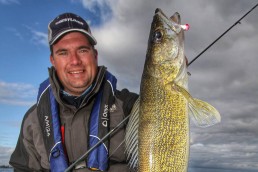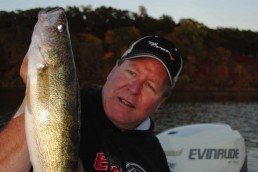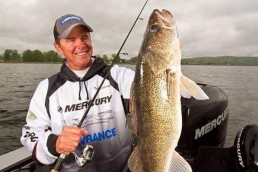Playing the Currents for Big Fall Funnel Walleyes
SHARE THIS POST
Currents attract walleyes all year and what might surprise anglers is just how much current affects their location and movements. Even large, natural lakes have currents that occur as wind pushes water to one side of the lake. Even after the wind dies down, there can be current created as the water levels off and moves back and in the opposite direction.
The current factor on reservoirs and flowages is even more obvious, and rivers always have it.
Currents can effect how quickly you find the walleyes in fall. This species loves current now and they often congregate into any incoming tributary or river system. Many anglers have referred to this fall run in rivers and reservoirs as a “false spawning run,” as these movements resemble the same spring migration.
However, I don’t believe this movement of fish is simply “practice” for procreation. The amount of baitfish that concentrates in current when the temperatures fall is incredible. And the walleyes are simply opportunistic, and these migrations in September are all about forage. Walleyes running up the river systems provide opportunities, but some of the most overlooked walleye patterns happen on natural lakes and flowages where they concentrate around bottlenecks and funnel areas that concentrate the current.
On many lakes, causeways and bridges built between lakes, the current attracts walleyes. Many narrow gaps that connect lakes are prime locations. If there is any depth and moving water here, there will almost always be ‘eyes around.
Other top locations are bottlenecks created by islands or the points that basically neck down the water to increase current flow. If there is visible current, it’s enough. We have seen ideal locations that range 5 to 30 feet. What makes these locations good is that these spots keep recharging with new fish. Some of the biggest walleyes caught in fall come these areas.
Are you enjoying this post?
You can be among the first to get the latest info on where to go, what to use and how to use it!
Presentations and strategies can run the gamut, but walleye fishing now can often revolve around jigs and cranks. Some fisheries produce after-dark bites for big fish where shallow-running stickbaits can be either trolled or cast from shore or by using waders. Anchoring or slipping the current with jigs is another proven strategy. Daytime bites often occur in deeper water, whereas after-dark patterns often happen shallow. Many of these locations can be fairly unassuming to anglers not in the know; a small bridge connecting two lakes is all that it takes.
People often tout spring as one of the best opportunities for cracking trophy walleyes, arguing that spring spawning conditions concentrate fish and big female walleyes are at their heaviest prior to spawn. But again, fall fishing around any current can be just as good. Fish are in prime condition from the ample fall feeding opportunities, females are starting to carry egg mass and the fish are concentrated—anglers covet this “triumvirate.”
As a general rule of thumb, fall presentations need to be bulked up. Suspending any shallow-running stickbaits and swimbaits can work in less than 7 feet of water. Larger stickbaits, like the Salmo Suspending Sting, have loud rattles and two larger treble hooks (work well for keeping big fish pinned up). Large, 4- to 5-inch swimbaits can also work extremely well. In my experience, I have done better throwing the swimbaits during the day and better on shallow-running hard baits after dark. Swimbaits like the Kalins Sizmic Shad with large thumping paddle tails are usually the ticket.
Deeper patterns can also occur, depending on the location. And jigging below the boat can be productive in specific current seams or troughs, combined with the right depths and current. There are times where fish lay out in front of the current in a deep hole or breakline in front of a bottleneck. These fall funnel locations are not necessarily always shallow or right in the bottleneck. Fish load up in the deep water close to any moving water in fall. Since these locations can be tight and small, staying over the top with a jig can be efficient.
Because of the decreased competition on the water in fall, walleye opportunities can be overlooked. Pressure falls as many outdoorsmen trade in fishing rods for shotguns. But committed anglers fish through the fall, and these current patterns can produce the best walleyes of the season. And some of the biggest fish are a real possibility.
Jason Mitchell is a top walleye guide on Devils Lake, N.D. He is the host for the outdoor program, “Jason Mitchell Outdoors.” Visit jasonmitchelloutdoors.com for more info.
MWO
SHARE THIS POST
Did you enjoy this post?
You can be among the first to get the latest info on where to go, what to use and how to use it!
Jason Mitchell
Jason Mitchell was a top walleye guide on Devils Lake, N.D. for nearly 20 years. Today, Mitchell produces the Jason Mitchell Outdoors TV program. Visit jasonmitchelloutdoors.com for more.



